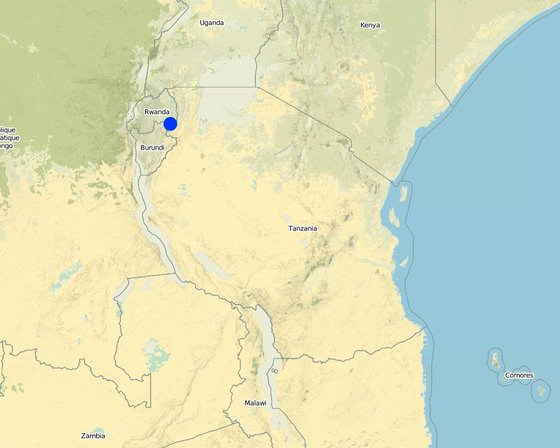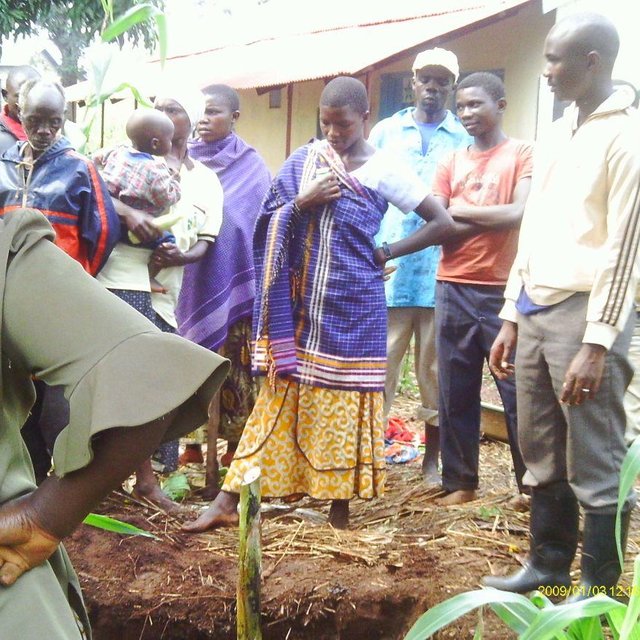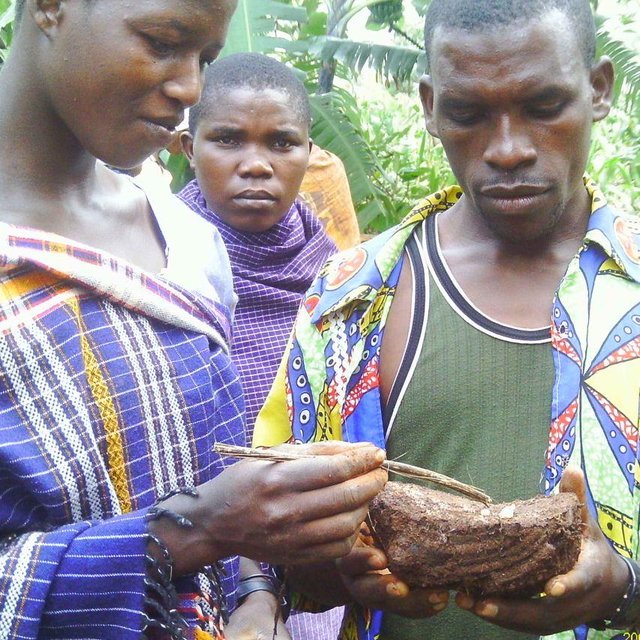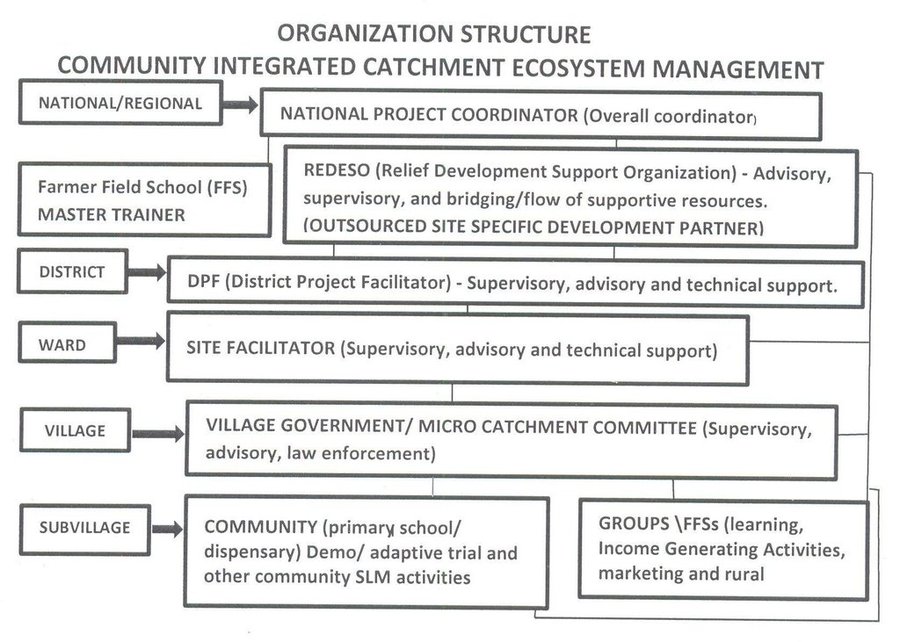Community intergrated catchment ecosystem management
(تنزانيا، جمهورية تنزانيا المتحدة)
Mfumo wa usimamizi wa ekolojia katika eneo bonde (Swahili)
الوصف
Adaptive Agro-ecosystem Micro-catchment Approach.
Aims / objectives: SLM knowledge skill generation and capacity building. Improved group and community strength, sustainability, organization and their capacity to benefit and invest in SLM. Motivation of community participation in SLM through use of quick win project, income generating activities, rural micro finance institutions, marketing and active engagement of disadvantaged groups.
Methods: Wider promotion of basket of choice of SLM technologies through SLM Farmer Field School, Demonstration plots and community related activities. Make use and build on already existing and new groups, existing institutions and the community as a whole. Strategic use of easily available and accessible available community institutions/ infrastructures (school and dispensaries sites) to demonstrate and promote basket of choice of SLM technologies. Learning by doing on the job, practical training, adoption and adaptation to local reality.
Stages of implementation: Site characterization through land degradation analysis (LADA) and development of community site specific SLM plan exemplifying SLM interventions needed to address the identified degradation types. Set up and identification of approaches needed to execute identified interventions complementary approaches. Sensitization and awareness creation to the community and actual execution of approaches.
Role of stakeholders: Individual groups: are core implementers and potential beneficiaries of the project.
Extension worker: Advisory and technical backstopping.
Elected and employed leaders at the sub-village, village and ward level: bylaw/law enforcement, supervisory and land provision.
Relief for Development Societies NGO (REDESO): Service provision and development partner in SLM.
Trans boundary Agro-ecosystem Management Project (TAMP): Provision of supportive resources (financial and technical).
Ngara district council: Supervisory, technical, policy interpretation, monitoring and evaluation, documentation, analysis and shairing .
Rugenge/Kirusha Micro catchment Committee: Supervisory, advisory and law enforcement.
الموقع

الموقع: Ngara, Tanzania, تنزانيا، جمهورية تنزانيا المتحدة
المرجع الجغرافي للمواقع المختارة
تاريخ البدء: 2010
سنة الإنهاء: 2014
نوع النهج
-
تقليدي/أصلي
-
مبادرة محلية حديثة/مبتكرة
-
قائم على مشروع/برنامج

Farmer Field School in training (Iddiphonce Mwasikundima (box 30 Ngara Kagera Tanzania))

Farmers observing pests in banana during agro ecosystem analysis (AESA) (Iddiphonce Mwasikundima (box 30 Ngara Kagera Tanzania))
غايات النهج والبيئة المواتية
الغايات/الأهداف الرئيسية للنهج
The Approach focused mainly on SLM with other activities (Motivating quick win income generation activities, rural microfinance institutions, marketing and HIV/AIDS controll.)
Knowledge/skill generation, demonstration and sustainability of SLM activities.
Motivate active participation of the community.
Inculcate a sense of community ownership/ community take charge of SLM activities.
The SLM Approach addressed the following problems: Lack of technical knowledge
Low investment capacity
Malpractice and mismanagement of local resources (e.g. fire burning, ploughing along the slope).
Adequate supervision, monitoring and law enforcement.
الشروط التي تمكن من تنفيذ التقنية/التقنيات المطبقة في إطار النهج
-
الإطار القانوني (حيازة الأراضي، وحقوق استخدام الأراضي والمياه): The existing land ownership, land use rights / water rights helped a little the approach implementation: Hindrance is usually observant for approaches which need long term commitment of land resources (e.g perennial crops) but is minimal for short term (annuals and biannual).
Open access land resources are difficult to manage.
الظروف التي تعيق تنفيذ التقنية/التقنيات المطبقة في إطار النهج
-
المعايير والقيم الاجتماعية /الثقافية/ الدينية: Negative cultural believes that fire burning can lead to one living long or reach older age.
Treatment through the SLM Approach: Change of mind set through FFS training, demos and community sensitization.
-
توفر/الوصول إلى الموارد والخدمات المالية: Low investment capacity and inability to access supportive resources
Treatment through the SLM Approach: Easy access to TAMP supportive resources.
-
الإطار المؤسساتي: Narrow coverage of the district, local institutions not involved in in SLM.
Treatment through the SLM Approach: Higher coverage, ope-rationalization of SLM in LGA system.
-
الإطار القانوني (حيازة الأراضي، وحقوق استخدام الأراضي والمياه): Reluctance of the village to issue land, less protection of open access land resources.
Treatment through the SLM Approach: land issuing for FFS/Demo use legally recognized through signing of Memorandum Of Understanding (MOU) between the village and land users/SLM groups. Bylaws reinforcement to protect mismanagement of open access land resources.
-
المعرفة حول الإدارة المستدامة للأراضي، والوصول إلى الدعم الفني: Inadequate understanding and use of SLM technical knowledge (both scientific and indigenous) to address land degradation problems.
Treatment through the SLM Approach: Up scaling use of scientific SLM knowledge.
Documentation, evaluation, analysis and sharing of successful indigenous SLM technical knowledge.
-
عبء العمل، توفر القوى العاملة: High workload to extension officers (due to their shortage).
Treatment through the SLM Approach: Build a local resource base in facilitating SLM activities through introduction of community SLM facilitators and Micro-catchment committee.
-
غير ذلك: Low motivation due to long term realization of SLM benefits.
Treatment through the SLM Approach: introduce SLM related quick win projects and income generation activities (IGA).
مشاركة وأدوار الأطراف المعنية
الأطراف المعنية بالنهج وأدوارها
| ما هي الجهات المعنية / الكيانات المنفذة التي شاركت في النهج؟ |
حدد الأطراف المعنيين |
وصف أدوار الأطراف المعنية |
| مستخدمو الأراضي المحليون/المجتمعات المحلية |
Core implementors. all gender, youth and elders . Widows, Orphans, People living with HIV/AIDS were actively indiscriminately involved in FFS, Demos and community related activities.. |
|
| متخصصون في الإدارة المستدامة للأراضي / مستشارون زراعيون |
all gender, youth and elders |
|
| المعلمون / أطفال المدارس / الطلاب |
all gender, youth and elders |
|
| منظمة غير حكومية |
|
dvisory, technical back stopping, supervisory and monitoring. |
| الحكومة المحلية |
|
Advisory, technical back stopping, supervisory and monitoring. |
| الحكومة الوطنية (المخططون، صانعو القرار) |
|
dvisory, technical back stopping, supervisory and monitoring. |
| منظمة دولية |
|
dvisory, supervisory and monitoring. |
الوكالة الرائدة
Land user (all genders, youth and elders): consulted and made informed decision about the approach to be used. National specialists: potential facilitators in designing and community sensitization. International specialists: consultative and subject matter specialist (e.g. FFS specialist)
انخراط مستخدمي الأراضي المحليين/المجتمعات المحلية في المراحل المختلفة للنهج
غير موجود
سلبي
الدعم الخارجي
تفاعلي
التعبئة الذاتية
المبادرة/التحفيز
Community, groups, employed and elected leaders: participated in sensitization and awareness creation process.
التخطيط
Community, groups, employed and elected leaders: active participants and decision makers in planning e.g. selection of FFS community facilitators and formation of micro-catchment committee.
التنفيذ
Community, groups, employed and elected leaders: core and key implementers of the approach.
الرصد/التقييم
Community, groups, employed and elected leaders: self mobilized and client interactive monitoring.
Research
Community, groups, employed and elected leaders: site identification and active implementers of adaptive trials (e.g use of fanya juu/chini terraces, vertivar grass e.t.c). Adopters, users and promoters of the best bets technologies.
مخطط التدفق
organization structure of community integrated catchment ecosystem management.

المؤلف: Allan Isaka Bubelwa (Box 38 Kyaka Missenyi Kagera Tanzania)
اتخاذ القرار بشأن اختيار تقنية الإدارة المستدامة للأراضي
وقد تم اتخاذ القرارات من قبل
-
مستخدمو الأراضي وحدهم (المبادرة الذاتية)
-
مستخدمو الأراضي بشكل أساسي، بدعم من متخصصي الإدارة المستدامة للأراضي
-
جميع الجهات الفاعلة ذات الصلة، كجزء من نهج تشاركي
-
متخصصون في الإدارة المستدامة للأراضي بشكل أساسي، بعد التشاور مع مستخدمي الأراضي
-
متخصصون في الإدارة المستدامة للأراضي بمفردهم
-
السياسيون / القادة
تم اتخاذ القرارات بناء على
-
تقييم المعرفة الموثقة جيدًا بشأن الإدارة المستدامة للأراضي(اتخاذ القرارات القائمة على الأدلة)
-
نتائج البحوث
-
خبرة وآراء شخصية(غير موثقة)
الدعم الفني وبناء القدرات وإدارة المعرفة
شكلت الأنشطة أو الخدمات التالية جزءًا من النهج
-
بناء القدرات/التدريب
-
خدمة استشارية
-
تعزيز المؤسسات (التطوير التنظيمي)
-
الرصد والتقييم
-
البحوث
بناء القدرات/التدريب
تم تقديم التدريب للأطراف المعنية التالية
-
مستخدمو الأراضي
-
موظفون ميدانيون/ مستشارون
-
employed and elected leaders
شكل التدريب
-
في العمل
-
من مزارع إلى مزارع
-
مناطق العرض
-
اجتماعات عامة
-
دورات
المواضيع المغطاة
SLM related subjects
خدمة استشارية
تم تقديم الخدمة الاستشارية
-
في حقول مستخدمي الأراضي
-
في مراكز دائمة
Name of method used for advisory service: Farmer field schools (FFS); Key elements: Practical training and learning by doing., Basket of choice of Technologies/Demos., Group oriented and site specific; Adoption depends on farmers choice and ability to invest.
Advisory service is inadequate to ensure the continuation of land conservation activities; There is limited knowledge and low funding capacity.
تعزيز المؤسسات
تم تعزيز/إنشاء المؤسسات
-
لا
-
نعم، قليلا
-
نعم، باعتدال
-
نعم، إلى حد كبير
صف المؤسسة والأدوار والمسؤوليات والأعضاء وما إلى ذلك.
نوع الدعم
-
مالي
-
بناء القدرات/التدريب
-
معدات
مزيد من التفاصيل
Training provision to micro-catchment committee.
الرصد والتقييم
bio-physical aspects were ad hoc monitored by project staff, government, land users through observations; indicators: hactarage conserved
bio-physical aspects were ad hoc monitored by project staff, government, land users through measurements; indicators: hactarage conserved
technical aspects were regular monitored by project staff, government, land users through observations; indicators: number of adopters
technical aspects were regular monitored by project staff, government, land users through measurements; indicators: number of adopters
socio-cultural aspects were regular monitored by project staff, government, land users through observations; indicators: % involvement of women
socio-cultural aspects were regular monitored by project staff, government, land users through measurements; indicators: % involvement of women
economic / production aspects were regular monitored by project staff, government, land users through observations; indicators: % increase in yield and income
economic / production aspects were regular monitored by project staff, government, land users through measurements; indicators: % increase in yield and income
area treated aspects were regular monitored by project staff, government, land users through observations; indicators: hactarage conserved
area treated aspects were regular monitored by project staff, government, land users through measurements; indicators: hactarage conserved
no. of land users involved aspects were regular monitored by project staff, government, land users through observations; indicators: number of adopters
no. of land users involved aspects were regular monitored by project staff, government, land users through measurements; indicators: number of adopters
management of Approach aspects were regular monitored by project staff, government, land users through observations; indicators: Number of FFS, Demos and IGA
management of Approach aspects were monitored through measurements; indicators: umber of FFS, Demos and IGA
There were several changes in the Approach as a result of monitoring and evaluation: Introduction of FFS farmer facilitators and Micro-catchment committees.
There were few changes in the Technology as a result of monitoring and evaluation: In the course of implementation adjusting or modifying technologies to suit agro-ecological condition or landforms
البحوث
تناول البحث المواضيع التالية
-
علم الاجتماع
-
الاقتصاد / التسويق
-
علم الايكولوجيا
-
تكنولوجيا
-
adaptive SLM trials
Adaptive SLM trials run by community/district/ARI Maruku through demos where farmers can select the best bets to apply and try on their own fields.
Research was carried out on-farm
التمويل والدعم المادي الخارجي
الميزانية السنوية بالدولار الأمريكي لمكون الإدارة المستدامة للأراضي
-
< 2000
-
10,0000-2,000
-
100,000-10,000
-
1,000000-100،000
-
> 1,000,000
Precise annual budget: غير متاح
Approach costs were met by the following donors: international (TAMP): 50.0%; government (Region/ARI Maruku.): 10.0%; local government (district, county, municipality, village etc) (Ngara district council, Villages and Ward): 20.0%; local community / land user(s) (Local community and groups withi the microcatchment ): 20.0%
تم تقديم الخدمات أو الحوافز التالية لمستخدمي الأراضي
-
الدعم المالي/المادي المقدم لمستخدمي الأراضي
-
إعانات لمدخلات محددة
-
الائتمان
-
حوافز أو وسائل أخرى
الدعم المالي/المادي المقدم لمستخدمي الأراضي
معدات: أدوات
Working gears (gun boots, raincoats, T-shirts)
Livestock
Chicken, goats and bees
العمل من قبل مستخدمي الأراضي كان
-
تطوعي
-
الغذاء مقابل العمل
-
مدفوع نقدا
-
مقابل دعم مادي آخر
تحليل الأثر والتصريحات الختامية
آثار النهج
لا
نعم، قليلا
نعم، باعتدال
نعم، إلى حد كبير
هل ساعد النهج مستخدمي الأراضي على تنفيذ وصيانة تقنيات الإدارة المستدامة للأراضي؟
Knowledge and skill acquired through FFS, Demos and community related intervention played significant role in improvement of SLM. Bylaw reinforcement significantly prevented malpractices/land resource mismanagement.
هل ساهم النهج في تمكين الفئات المحرومة اجتماعيا واقتصاديا؟
Improved to livelihood mechanism/alternates to widow, orphan and people living with HIV/AIDS
هل أدى النهج إلى تحسن في مسائل حيازة الأراضي / حقوق المستخدمين التي أعاقت تنفيذ تقنيات الإدارة المستدامة للأراضي؟
The approach involve signing of memorandum of understanding (MOU) over use of land resource between farmer groups running Demos and FFS and the village government. MOU is a strong and reliable legal acquisition of land resource to be used for conservation activities.
Did other land users / projects adopt the Approach?
On average each FFS member induced adoption to 2 household farmers.
المحفز الرئيسي لقيام مستخدمي الأراضي بتنفيذ الإدارة المستدامة للأراضي
-
زيادة الإنتاج
-
زيادة الربح (القدرة)، وتحسين نسبة التكلفة إلى العائد
-
الحد من تدهور الأراضي
-
الحد من مخاطر الكوارث
-
انخفاض عبء العمل
-
المدفوعات/ الإعانات
-
القواعد واللوائح (الغرامات) / الإنفاذ
-
الوجاهة والضغط الاجتماعي/التماسك الاجتماعي
-
الانتماء إلى حركة/ مشروع/ مجموعة/ شبكات
-
الوعي البيئي
-
العادات والمعتقدات والأخلاق
-
تعزيز المعرفة والمهارات في مجال الإدارة المستدامة للأراضي
-
تحسينات جماليية
-
التخفيف من حدة الصراع
-
well-being and livelihoods improvement
استدامة أنشطة النهج
هل يمكن لمستخدمي الأراضي الحفاظ على استدامة ما تم تنفيذه من خلال النهج (بدون دعم خارجي)؟
Farmers have realized the benefit of SLM. The village historical track records and experience indicate that farmers in Kirusha village usually continue what ever they come to realize is implemented for their own benefit. Further more, establishment of local human resource in SLM in terms of FFS facilitators and micro-catchment committee and their ope-rationalization into LGA systems is an assure way towards sustainability.
Motivation induced through quick win income generating activities (goat production, chicken, piggery, fruit tree nurseries and apiaries) and easy to manage demo set at Kirushya primary school and dispensary (reachable and easily accessible) are added assurance for project sustainability.
الاستنتاجات والدروس المستفادة
نقاط القوة: وجهة نظر مستخدم الأرض
-
Learning and acquisition of knowledge (How to sustain/ enhance this strength: continuation of FFS, Demo and community activities.)
-
Cohesiveness and self help (How to sustain/ enhance this strength: Continue promotion of VICOBA and Market. )
-
Spread of knowledge within and outside village. (How to sustain/ enhance this strength: Continue use of the approach. )
نقاط القوة: وجهة نظر جامع المعلومات أو غيره من الأشخاص الرئيسيين لمصدر المعلومات
-
Improved relationship, unity, cohesiveness and common voice. (How to sustain/ enhance this strength: Continue with promotion, strengthening and establishment of IGA, SACCAS and VICOBA.)
-
More farmers are involved (rapid adoption and expansion) (How to sustain/ enhance this strength: Up scaling and strengthening of FFS, Demos, and IGA. )
-
The approach is cost effective (benefit surpass costs) (How to sustain/ enhance this strength: Promote, expand and continue use of FFS, Demos and IGA.)
-
Assured and promising elements of sustainability. (How to sustain/ enhance this strength: Strengthen ope-rationalization and use of micro-catchment committee and FFS facilitators. )
-
Easy access to supportive resources
(Land and financial) (How to sustain/ enhance this strength: strengthen and liaise FFS with service providers
(Bank, SACCOS and Marketing))
نقاط الضعف / المساوىء / المخاطر: وجهة نظر مستخدم الأرضكيفية التغلب عليها
-
Negative customs and believes
(it is believed that one can live longer and reach older age by setting fire and burning of a large area).
Discourage negative custom and believes
-
Reluctance of household heads especially in patrimonial societies.
Community sensitization to gender (gender be addressed as the basic component of the approach).
-
Failure and negative experience of past development projects and programmes.
Change of mind set
-
Shortage of inputs and working facilities
Promote availability and accessibility of inputs and working facilities.
نقاط الضعف / المساوىء / المخاطر: وجهة نظر جامع المعلومات أو غيره من الأشخاص الرئيسيين لمصدر المعلوماتكيفية التغلب عليها
-
Selfishness, individualism by some untrustworthy politicians and leaders.
Combine SLM promotion with civic education training.
-
Prone to natural calamities and disastrous events
Introduce and strengthen use of Agro-based insurance.
-
Largely relies on government or farmer willingness to release and offer land.
Sensitize and encourage use of MOU.
-
If not done in precaution can perpetuate dependency syndrome
Encourage use of self mobilized farmer groups and their strengthening and ope-rationalization into existing systems.
-
Reliable external supportive resource needed initially
Reliable and timely supply of supportive resources.
المراجع
تاريخ التوثيق: 10 مارس، 2014
اخر تحديث: 6 يوليو، 2017
الأشخاص الرئيسيين لمصدر المعلومات
-
ALLAN BUBELWA (allan.bubelwa@gmail.com) - متخصص في الإدارة المستدامة للأراضي
-
Bertha Munyaga (bkmunyaga@yahoo.com) - متخصص في الإدارة المستدامة للأراضي
-
Philip Ileta (iletaphilip@yahoo.com) - متخصص في الإدارة المستدامة للأراضي
-
Idephonce Mwasikundima - متخصص في الإدارة المستدامة للأراضي
الوصف الكامل في قاعدة بيانات WOCAT
بيانات الإدارة المستدامة للأراضي المرتبطة
تم تسهيل التوثيق من قِبَل
المؤسسة
- Bukoba district council (Bukoba district council) - تنزانيا، جمهورية تنزانيا المتحدة
- Ngara District Council (Ngara District Council) - تنزانيا، جمهورية تنزانيا المتحدة
المشروع
المراجع الرئيسية
-
Site characterization report: Kimamba Lyoba, :







